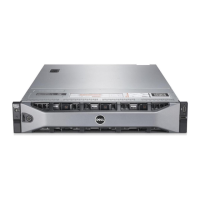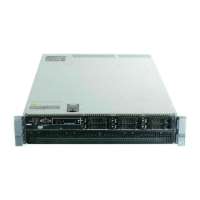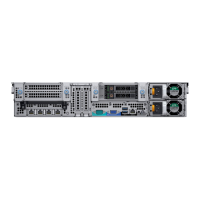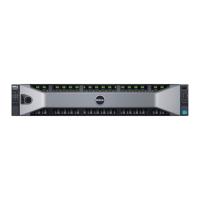Dell
PowerEdge R815 Technical Guide 30
6 Memory
6.1 Overview
The Dell™ PowerEdge™ R815 uses DDR3 memory which provides a high-performance, high-speed
memory interface capable of low latency response and high throughput. The platform supports
Registered ECC DDR3 DIMMs (RDIMM) and Unbuffered DDR3 DIMMs (UDIMM).
The memory interface supports memory scrubbing (sequential or redirection) and patrol scrubbing,
single-bit correction and multi-bit error detection. The failure of a x4 DRAM device results in errors
to one ECC symbol and can be corrected (chipkill). The failure of a x8 DRAM device results in errors
to two ECC symbols, and can be detected but cannot be corrected.
• If DIMMs of different speeds are mixed, all channels will operate at the fastest common
frequency.
• If online sparing is enabled, identical DIMMs must be installed in the same slots across each
channel.
• The first DIMM slot in each channel is color-coded with white ejection tabs for ease of
installation.
• The DIMM sockets are placed 440 mils (11.12 mm) apart, center-to-center in order to provide
enough space for sufficient airflow to cool stacked DIMMs.
• The R815 memory system supports up to 32 DIMMs. Population order is identified by the
silkscreen designator and the System Information Label (SIL) located on the chassis cover.
6.2 DIMMs Supported
The interface uses 1 GB, 2 GB, 4 GB, 8 GB, 16 GB, and 32 GB RDIMMs and 2 GB UDIMMs.
The memory interface supports memory demand and patrol scrubbing, single-bit correction and
multi-bit error detection.
Systems configured with two memory modules per channel support up to 1600 MT/s memory.
6.3 Slots
The DDR3 memory interface consists of 4 memory channels per processor socket. Each channel
supports up to two RDIMMs for single/dual/quad rank or two UDIMMs. Each channel is capable of
supporting up to two DDR3 memory modules. For more information, see the System Memory section
in the Installing System Components chapter of the PowerEdge R815 Hardware Owner’s Manual on
Support.Dell.com/Manuals
.
6.4 Speed
Each processor has 4 DDR3 channels capable of supporting speeds up to 1600 MT/s according to the
following requirements:
• Single and dual-rank DIMMs support speeds up to 1600 MT/s.
• Quad-rank DIMMs can support speeds up to 1066 MT/s.
• If DIMMs of different speeds are mixed, all channels will operate at the fastest common
frequency.

